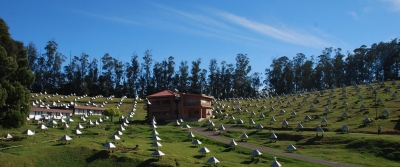
GRAPES-3 is designed to study cosmic rays with an array of air shower detectors and a large area muon detector. It aims to probe acceleration of cosmic rays in the following four astrophysical settings.
The GRAPES-3 is located at N11.4o, E76.7o, 2200m above mean sea level. The observations began with 217 plastic scintillators and a 560 m2 area muon detector in 2000. The scintillators detect charged particles contained in extensive air showers produced by interaction of high energy cosmic rays in the atmosphere. At present the array is operating with ~400 scintillators that are spread over an area of 25,000 m2. The energy threshold of muon detectors is 1 GeV.
In continuation of the work on cosmic ray research at CRL, GRAPES-1 experiment was upgraded in various stages to GRAPES-2. However, due to the technical and administrative problem in its further expansion, a new experiment was set up at the RAC site 8 km from the old site which is called GRAPES-3. The GRAPES-3 experiment at present is operating with ~400 (each 1 m2) plastic scintillator detectors with a separation of 8 meters, to record the density and arrival time of particles in cosmic ray showers, and in continuous operation. At present, GRAPES-3 array is the highest density conventional EAS array in the world, and also, this experiment associated with a huge 560 m2 area tracking muon detector, is also the largest area tracking detector anywhere.
Picture Credit : Google




